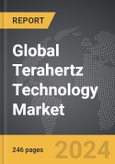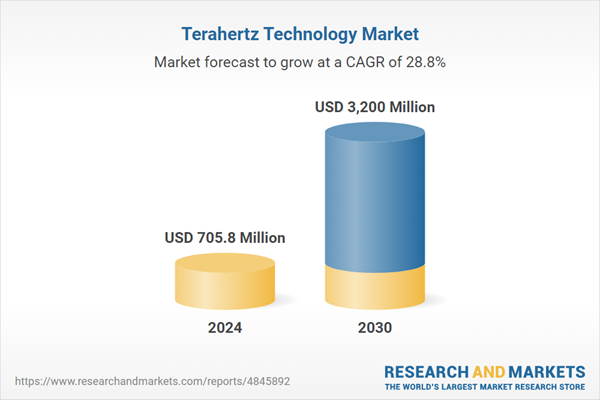The global market for Terahertz Technology was valued at US$705.8 Million in 2024 and is projected to reach US$3.2 Billion by 2030, growing at a CAGR of 28.8% from 2024 to 2030. This comprehensive report provides an in-depth analysis of market trends, drivers, and forecasts, helping you make informed business decisions. The report includes the most recent global tariff developments and how they impact the Terahertz Technology market.
Segments: Application (Terahertz Imaging Systems, Terahertz Spectroscopy Systems, Terahertz Communication Systems); Technology (Terahertz Source, Terahertz Detector).
Geographic Regions/Countries: World; United States; Canada; Japan; China; Europe (France; Germany; Italy; United Kingdom; and Rest of Europe); Asia-Pacific; Rest of World.
The analysts continuously track trade developments worldwide, drawing insights from leading global economists and over 200 industry and policy institutions, including think tanks, trade organizations, and national economic advisory bodies. This intelligence is integrated into forecasting models to provide timely, data-driven analysis of emerging risks and opportunities.
Global Terahertz Technology Market - Key Trends and Drivers Summarized
What Is Terahertz Technology and Why Is It Gaining Importance?
Terahertz (THz) technology operates in the electromagnetic spectrum between microwave and infrared frequencies, offering unique capabilities for imaging, spectroscopy, and communication. Terahertz waves can penetrate materials like plastics, fabrics, and wood without damaging them, making this technology particularly useful in non-destructive testing, security scanning, and medical imaging. Additionally, terahertz radiation has potential in next-generation wireless communication systems due to its ability to carry vast amounts of data over short distances with minimal interference. As industries such as healthcare, security, and telecommunications seek innovative solutions for their evolving challenges, terahertz technology is emerging as a key enabler of new applications and market opportunities.How Is Terahertz Technology Applied Across Different Sectors?
The applications of terahertz technology span a wide range of industries, from healthcare to defense. In medical imaging, terahertz waves provide detailed, high-resolution images of tissues without the harmful effects associated with X-rays. This makes it an ideal tool for cancer detection and other diagnostic procedures. The security sector utilizes terahertz scanners for detecting concealed weapons or explosives, while the manufacturing industry applies this technology for non-destructive testing and quality control of materials such as composites and semiconductors. In telecommunications, terahertz waves are being explored for ultra-high-speed data transmission, potentially playing a vital role in the development of 6G networks.What Are the Key Market Segments for Terahertz Technology?
Types of terahertz systems include imaging systems, spectrometers, and communication systems. Imaging systems hold a significant share of the market due to their widespread use in security screening and medical diagnostics. Components of terahertz systems include sensors, transmitters, and detectors, with advancements in terahertz detectors driving innovation in real-time imaging. Application-wise, the market covers sectors such as healthcare, defense, telecommunications, and manufacturing. Geographically, North America leads the market, driven by strong research and development investments, while Asia-Pacific is witnessing rapid growth, particularly in the telecommunications and manufacturing sectors.The Growth in the Terahertz Technology Market Is Driven by Several Factors
The growth in the terahertz technology market is driven by several factors, including advancements in terahertz imaging and sensing technologies, increasing demand for security and non-destructive testing solutions, and the potential for terahertz communication in next-generation networks. The healthcare sector is also contributing to market expansion, with growing applications of terahertz imaging for diagnostics and cancer detection. Investments in research and development, particularly in the defense and telecommunications sectors, are fueling innovation in terahertz systems. As industries continue to explore the capabilities of terahertz waves for diverse applications, the market is expected to grow significantly in the coming years.Report Scope
The report analyzes the Terahertz Technology market, presented in terms of units. The analysis covers the key segments and geographic regions outlined below.Segments: Application (Terahertz Imaging Systems, Terahertz Spectroscopy Systems, Terahertz Communication Systems); Technology (Terahertz Source, Terahertz Detector).
Geographic Regions/Countries: World; United States; Canada; Japan; China; Europe (France; Germany; Italy; United Kingdom; and Rest of Europe); Asia-Pacific; Rest of World.
Key Insights:
- Market Growth: Understand the significant growth trajectory of the Terahertz Source segment, which is expected to reach US$1.8 Billion by 2030 with a CAGR of a 29.1%. The Terahertz Detector segment is also set to grow at 28.5% CAGR over the analysis period.
- Regional Analysis: Gain insights into the U.S. market, valued at $210.0 Million in 2024, and China, forecasted to grow at an impressive 27.6% CAGR to reach $477.8 Million by 2030. Discover growth trends in other key regions, including Japan, Canada, Germany, and the Asia-Pacific.
Why You Should Buy This Report:
- Detailed Market Analysis: Access a thorough analysis of the Global Terahertz Technology Market, covering all major geographic regions and market segments.
- Competitive Insights: Get an overview of the competitive landscape, including the market presence of major players across different geographies.
- Future Trends and Drivers: Understand the key trends and drivers shaping the future of the Global Terahertz Technology Market.
- Actionable Insights: Benefit from actionable insights that can help you identify new revenue opportunities and make strategic business decisions.
Key Questions Answered:
- How is the Global Terahertz Technology Market expected to evolve by 2030?
- What are the main drivers and restraints affecting the market?
- Which market segments will grow the most over the forecast period?
- How will market shares for different regions and segments change by 2030?
- Who are the leading players in the market, and what are their prospects?
Report Features:
- Comprehensive Market Data: Independent analysis of annual sales and market forecasts in US$ Million from 2024 to 2030.
- In-Depth Regional Analysis: Detailed insights into key markets, including the U.S., China, Japan, Canada, Europe, Asia-Pacific, Latin America, Middle East, and Africa.
- Company Profiles: Coverage of players such as Biospace LAB, Bruker Corporation, Carl Zeiss Meditec AG, Fluoptics, Hamamatsu Photonics KK and more.
- Complimentary Updates: Receive free report updates for one year to keep you informed of the latest market developments.
Some of the 46 companies featured in this Terahertz Technology market report include:
- Biospace LAB
- Bruker Corporation
- Carl Zeiss Meditec AG
- Fluoptics
- Hamamatsu Photonics KK
- KARL STORZ SE & Co. KG
- LI-COR, Inc. (LI-COR Biosciences)
- Miltenyi Biotec GmbH
- Mizuho Corporation
- Novadaq Technologies, Inc.
- PerkinElmer, Inc.
- Promega Corporation
Tariff Impact Analysis: Key Insights for 2025
Global tariff negotiations across 180+ countries are reshaping supply chains, costs, and competitiveness. This report reflects the latest developments as of April 2025 and incorporates forward-looking insights into the market outlook.The analysts continuously track trade developments worldwide, drawing insights from leading global economists and over 200 industry and policy institutions, including think tanks, trade organizations, and national economic advisory bodies. This intelligence is integrated into forecasting models to provide timely, data-driven analysis of emerging risks and opportunities.
What’s Included in This Edition:
- Tariff-adjusted market forecasts by region and segment
- Analysis of cost and supply chain implications by sourcing and trade exposure
- Strategic insights into geographic shifts
Buyers receive a free July 2025 update with:
- Finalized tariff impacts and new trade agreement effects
- Updated projections reflecting global sourcing and cost shifts
- Expanded country-specific coverage across the industry
Table of Contents
I. METHODOLOGYII. EXECUTIVE SUMMARY2. FOCUS ON SELECT PLAYERSIII. MARKET ANALYSISIV. COMPETITION
1. MARKET OVERVIEW
3. MARKET TRENDS & DRIVERS
4. GLOBAL MARKET PERSPECTIVE
UNITED STATES
CANADA
JAPAN
CHINA
EUROPE
FRANCE
GERMANY
ITALY
UNITED KINGDOM
REST OF EUROPE
ASIA-PACIFIC
REST OF WORLD
Companies Mentioned (Partial List)
A selection of companies mentioned in this report includes, but is not limited to:
- Biospace LAB
- Bruker Corporation
- Carl Zeiss Meditec AG
- Fluoptics
- Hamamatsu Photonics KK
- KARL STORZ SE & Co. KG
- LI-COR, Inc. (LI-COR Biosciences)
- Miltenyi Biotec GmbH
- Mizuho Corporation
- Novadaq Technologies, Inc.
- PerkinElmer, Inc.
- Promega Corporation
Table Information
| Report Attribute | Details |
|---|---|
| No. of Pages | 246 |
| Published | April 2025 |
| Forecast Period | 2024 - 2030 |
| Estimated Market Value ( USD | $ 705.8 Million |
| Forecasted Market Value ( USD | $ 3200 Million |
| Compound Annual Growth Rate | 28.8% |
| Regions Covered | Global |









